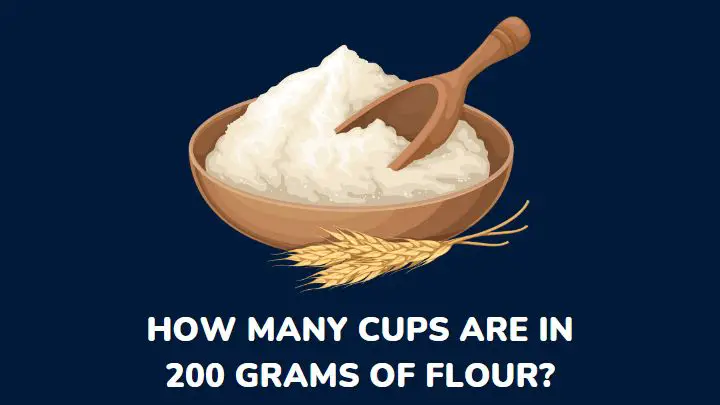If your recipe calls for 200 grams of flour, do you know how to get this quantity with measuring cups? Cooking and baking require a lot of measuring and converting.
Measurements and conversions cut across units and different tools. Kitchen scales, measuring cups, and spoons are the most common measuring tools. Cups, grams, and milliliters are the most common units.
In this article, you get to learn how many cups equals 200 grams of flour and if it is the same with all kinds of flour.
What is flour?
Simply put, flour is a powder made from grains, usually wheat. Although wheat is the ideal grain for flour, there are other starchy plant sources you can use to make flour.
These include rice, rye, peanuts, potatoes, soybeans, barley, buckwheat, corn, oats, and lima beans.
The different types of flour from these plants can be used to prepare a variety of treats and pastries such as biscuits, cookies, bread, pizza dough, waffles, pancakes, pasta, noodles, etc.
In addition, you can use cooking flour to coat your fried meat and seafood.
How can you convert grams to cups?
To convert a gram measurement to cups, divide the weight by 236.588236 times the material’s density.
As a result, the weight in cups is equivalent to the grams multiplied by 236.588236 and divided by the component or material’s density.
For the best outcome, use a digital scale to weigh your ingredients. It’s much easier that way.
How many cups are 200 grams of flour?
1 1/4 cups of flour equal 200g of flour.
How many cups are 200 grams of almond flour?
200g of almond flour is equal to 2.08 (~ 2) US cups.
Almond flour is produced from ground, blanched almonds. You can use it just as you do regular flour.
How many cups are 200 grams of rice flour?
200g of rice flour equals 1 US cup plus 4 tablespoons of rice flour. Rice flour is simply rice grains ground into powder. It is a suitable alternative to wheat flour.
How many cups are 200 grams of bread flour?
200g of bread flour is equivalent to 1.5 (~ 1 1/2) US cups. Typically, bread flour is mixed with yeast to produce bread. It is a flour high in protein. Ideally, a cup contains between 12 and 14% protein.
How many cups are 200 grams of self-rising flour?
The mixture of regular flour, baking powder, and salt gives you self-rising flour. This flour is a baking and frying flour.
It does not need added yeast because it rises on its own. 200g of self-rising flour is equal to 1 1/4 cups.
How many cups are 200 grams of all-purpose flour?
200g of all-purpose flour is equivalent to 1.67 (~ 1 3/4) US cups, or more specifically, 1.6673581213927.
All-purpose flour is a type of wheat flour designed for versatile and general use. It is made from hard red wheat. Also, it can be gotten from a mixture of hard and soft wheat with an 80:20 ratio.
How many cups are 200 grams of tapioca flour?
200g of tapioca flour amounts to 1.64 cups. Tapioca flour is gotten from the roots of cassava plants after a wet and dry milling procedure. It is a starchy and fibrous food powder.
How many cups are 200 grams of semolina?
200 grams of semolina equals 1.11 (~1) US cups. This means 200 grams of semolina will give you 1 US cup plus 1 level tablespoon of semolina.
Semolina is a high-gluten flour prepared from hard durum wheat. It has a coarse texture and is yellow-hued with a high gluten protein content.
Why do you need to measure flour?
Accurately measuring your flour makes a difference in your recipe. It affects how your recipe turns out.
Moreover, correctly weighing your flour is as important as the other cooking procedures. It balances the taste and texture you want.
FAQs
How many ounces are in 200 grams of flour?
200 grams of flour contains 7.054 ounces.
Can you measure flour in a regular cup?
Yes, you can. Measuring with a regular cup can be quite risky because the flour might be too much or too little, depending on the size of the cup.
Measurement is most effective when you use the right tools.
Should you sift flour before measuring?
Yes, you should sift flour if your recipe requires sifted flour. However, if your recipe does not require sifted flour, you may not sift it.
Conclusion
You can use a graded scale – either electrical or manual – to measure flour. You can also measure flour with a cup if you don’t have a graduated scale.
Fluff the flour in the bowl with a spoon, then scoop it into your cup using a spoon. Distribute it evenly around the measuring cup using a cutter or a knife.
Undoubtedly, if you can get your measurements accurately, the rest of your baking process will be smooth.
Thank you for reading.
You can also read articles on measurements and conversion on Millenora.

